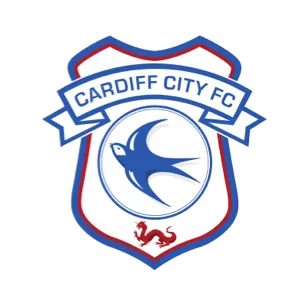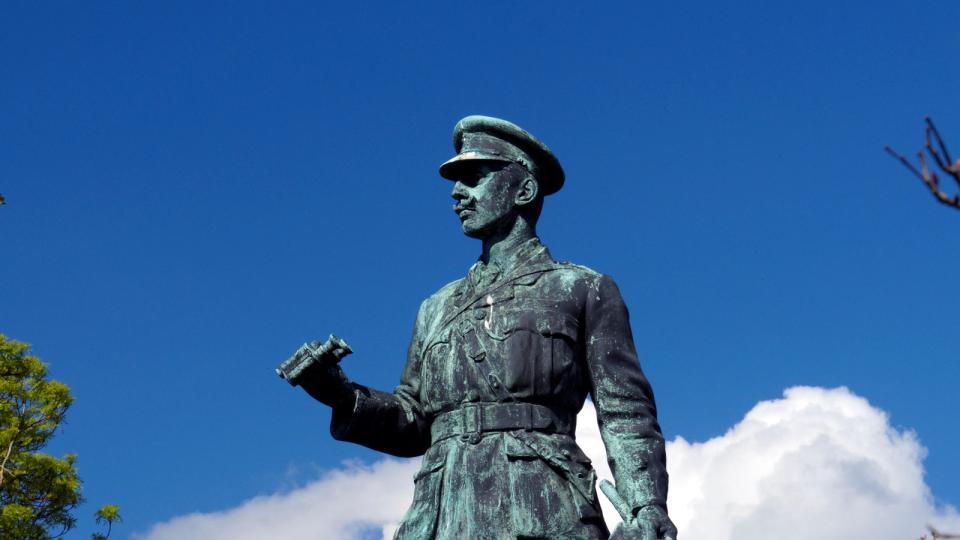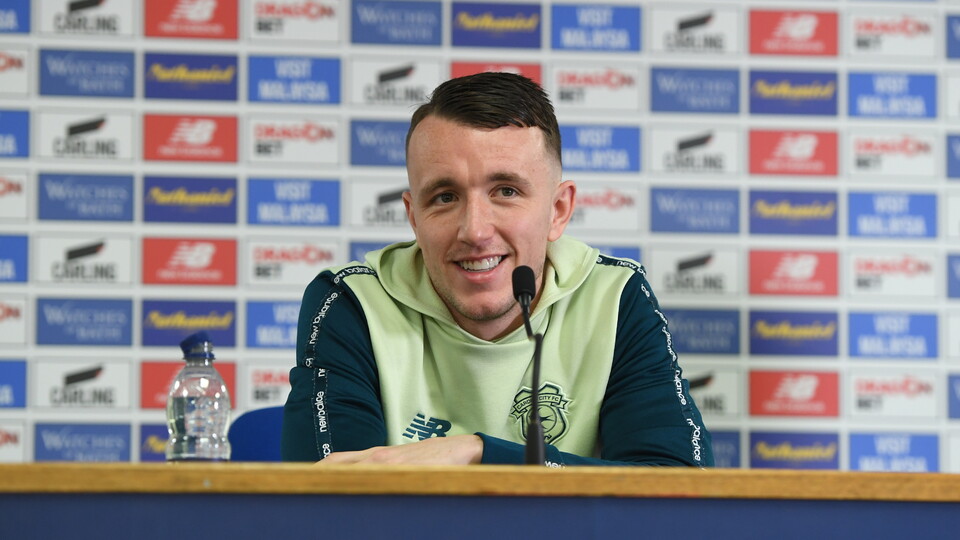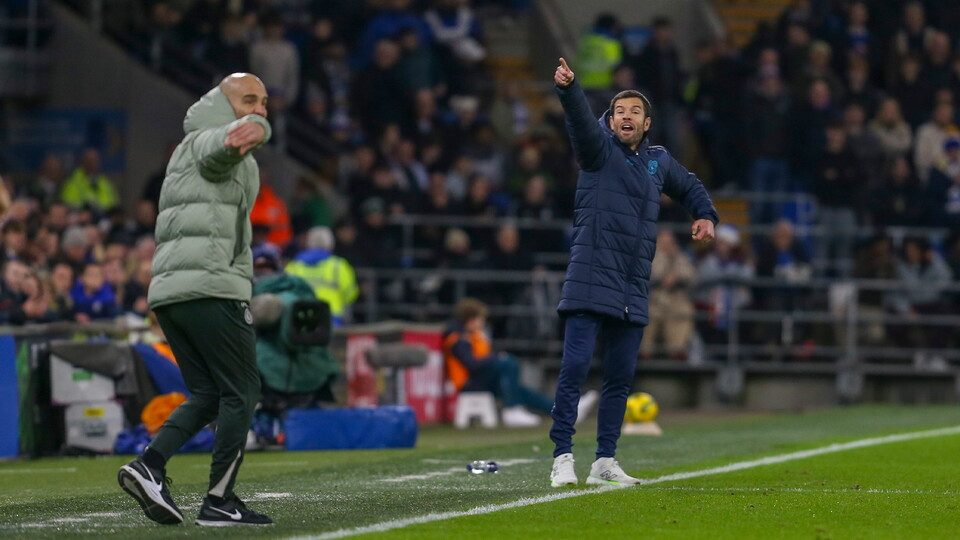Continuing the series of articles celebrating the lives of Bluebirds who fought for their country as we approach Remembrance Sunday, Mark Denham pays tribute to an icon of the Club's early history.
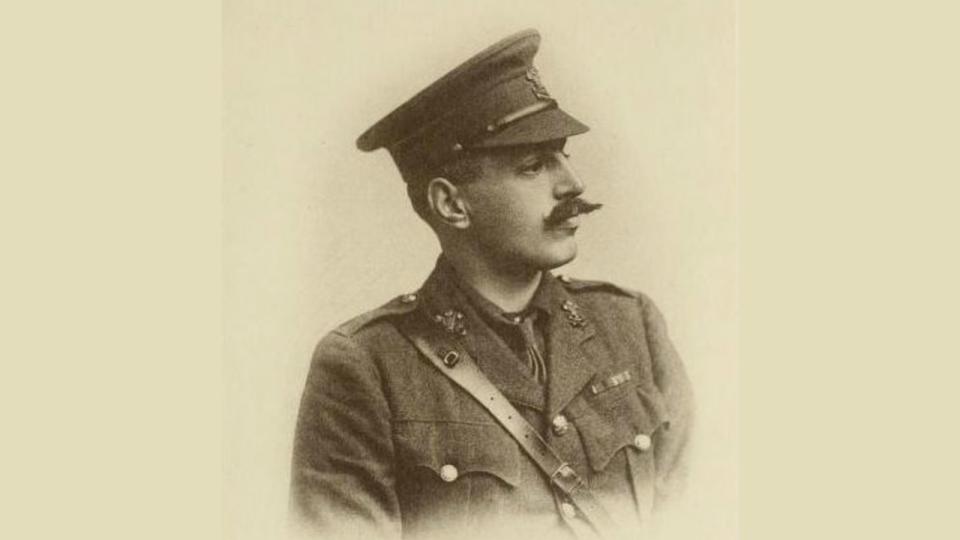
I must confess to not having known that a statue commemorating Lord Ninian Crichton-Stuart stood outside Cardiff Museum. Indeed, it was by chance that I stumbled across our distinguished benefactor’s monument in the summer of 2021, shortly after having come up with the idea of collating a series of Cardiff City war stories with my friend (and former history teacher), Matt Ferris.
Lord Ninian’s statue (sculpted by Sir William Goscombe John) is situated in the Gorsedd Gardens outside the Museum (flanked by Park Place and Greyfriars Road) in the company of other historical figures of Cardiff including the former Prime Minister of the United Kingdom, David Lloyd George. Whilst conducting my research for this piece, I noted that Ninian is also commemorated on Panel 8 of the Parliamentary War Memorial in Westminster Hall as one of 22 Members of Parliament who died in action during the Great War of 1914-1918. Ninian Road in Roath is named after him, as is Ninian Park Station and Ninian Park Primary School in Grangetown.
And so thus, having recently bumped into his statue and grown up surrounded by landmarks bearing that charming, distinctive Christian name, I decided that I would write my contribution for this unique historical series on the great Lord Ninian Crichton-Stuart.
It’s been a real pleasure doing so.

A cartoon of Lord Ninian published in Vanity Fair, during his time as Unionist candidate for Cardiff (1910).
Early Life
Ninian was born at Dumfries House in Ayrshire on May 15th, 1883. He was the second son of John Patrick Crichton-Stuart, 3rd Marquess of Bute and the Honourable Gwendoline Mary Anne Fitzalan-Howard, the eldest daughter of the first Baron Howard of Glossop. Ninian was a direct descendant on his father’s side of the Royal Stuarts (1603-1714) and, as such, was entitled to wear the Royal Stuart Tartan.
Having been academically proficient in mathematics and linguistics at school in Harrow, Ninian began the pursuit of life in the Diplomatic Service, travelling to learn Russian in Kiev (now the capital of Ukraine, then of Russian territories) only to be taken ill with a fever and being forced to return home. His father was already unwell and died whilst Ninian had been abroad, leaving the Falkland Estate in Fife, Scotland, to his son. Thereafter, Ninian studied at Christ Church College, Oxford, becoming a popular member of the varsity and taking a keen interest in sports: pastimes he would go on to value so highly in national life.
In 1903 he accepted a commission into the 3rd Battalion (militia) of the Queen’s Own Cameron Highlanders and would go on to serve for two years as an officer in the 1st Battalion of the Scots Guards as 2nd Lieutenant after graduating in 1905. A year later he would marry the Honourable Ismay Preston (subsequently Lady Ninian), daughter of Jenico Preston, the late 14th Viscount Gormanston, before resigning his commission in 1907 to take care of his Scottish estates and to enter the world of politics.
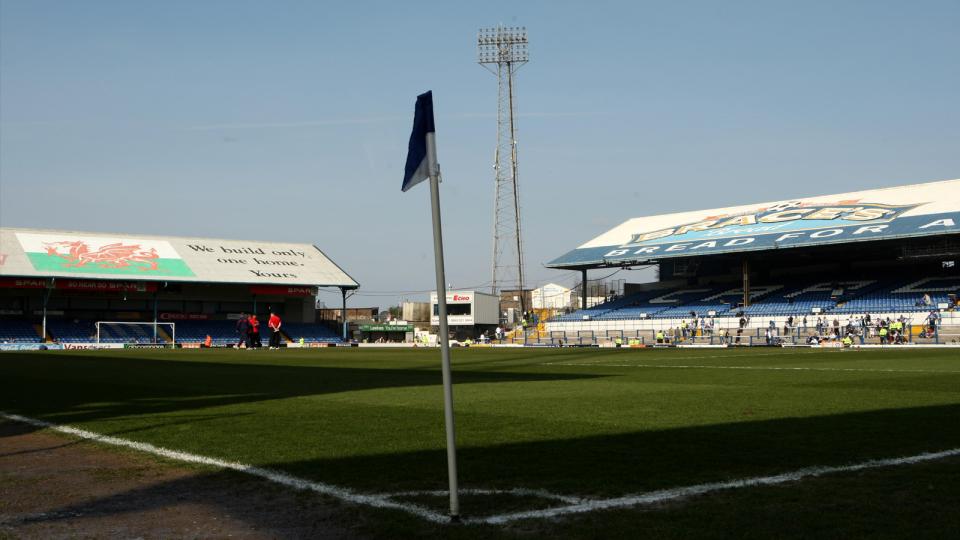
A Love of Cardiff
It is widely recognised that Ninian had retained a warmth for Cardiff having spent a good deal of his youth here whilst his father was in residence at Cardiff Castle. Having been acutely aware of his family’s close association with the industrial, economic, and social development of the then town throughout the 18th and 19th centuries, Ninian would be adopted in 1907 as the prospective Liberal Unionist candidate for the United Boroughs of Cardiff, Cowbridge and Llantrisant. He had been unanimously elected.
Ninian nursed the parliamentary seat with immense pride and civic duty for the next three years and, despite contesting and narrowly losing the seat early in January 1910, significantly reduced the Radicals’ majority (the Western Mail cartoonist J.M. Staniforth often depicted Ninian as the White Knight coming to save a distressed damsel [Cardiff] from the perceived constraints of Radicalism). Following a hung parliament, a second General Election was called and, on 7th December 1910, Ninian was elected Conservative MP for the Cardiff District of Boroughs. He was considered as being a popular man, in touch with the people, and fought for virtues such as ‘more employment for workers’; ‘workshops not workhouses’ and ‘reform of the poor law.’
In the months preceding Ninian’s ascension to Parliament, Cardiff City Football Club had secured the lease of a plot of land to build a new stadium. During development, one of the guarantors for the club pulled out and Lord Ninian instead offered his support of the project and acted as a guarantor for the £90 annual rent that the club had agreed to. In recognition of his role in the building of the ground, the club dropped the original planned name of the ground, Sloper Park, and instead named it Ninian Park. The ground was officially opened on 1st September 1910 (the club turned professional the same year) and Ninian performed the kick-off for a friendly match between Cardiff City and Football League First Division side Aston Villa. He was also a patron of the Lord Ninian Stuart Cup, a competition for local football teams.
Ninian Park would stand as Cardiff City’s home for the next 99 years, prior to hosting its final game against Ipswich Town in April 2009. Lord Ninian’s financial backing not only gave the club security but allowed it to smoothly enter the Southern Football League and, subsequently, the Football League in a new era of professionalism for the club and city. The Bluebirds would move to the new Cardiff City Stadium across the road in Leckwith for the start of the 2009/10 campaign, though their new home would incorporate the Ninian Stand and would re-house the famous Ninian Gates following demolition of the old ground. Fitting nods to the past and Lord Ninian’s contribution.
By this time, Ninian’s family had moved to Penylan Court in Cardiff. As a member of the House of Commons, Ninian excelled and impressed through his industry and application; he was said to be ever accessible and interested himself in the importance of issues relating to Cardiff and its affairs. He did much towards making the enfranchisement of leaseholders one of practical concern and spoke frequently against the disestablishment and disendowment of the Church. He had a great interest in agricultural matters and was made President of the largest agricultural societies in Scotland (his residence remained in Falkland, Fife) and two similar societies in Glamorgan. He was also an extremely popular landlord and for these reasons, became known colloquially as the ‘Farmer’s Friend.’
The Great War
Lord Ninian was killed at the age of 32 during the Battle of Loos in Flanders on 2nd October 1915, a year into the Great War and as a sitting member of parliament having held the seat for the Cardiff Boroughs for almost five years. He had been a Lieutenant-Colonel commanding on the Western Front for the 11 months prior having volunteered his Glamorgan Territorial battalion, the 6th Welsh Regiment, for service upon outbreak of war in 1914 (he had been appointed to his position within the battalion in 1912).
Having sailed to France on 28th October 1914, the 6th Welsh were first based in Boulogne and later St. Omer on the ‘lines of communication’ before being relocated to the trenches of Ypres in Belgium in the summer of 1915; Ninian was reportedly frustrated that they had not seen direct action sooner. On leaving Swansea, he is reported to have boldly told his young troops: “I am prepared, as I am sure you all are, to lay down my life for my country if it is required.” The battalion would move to be part of the Reserves with the British Expeditionary Force (BEF) for the Battle of Loos in late September 1915.
Ninian died a hero, leading an attack to try and save his friend Major Reginald C. Browning, who had been left behind in a German trench. He was shot in the head whilst stepping above the parapet to direct machine gun fire during a period of the war in which tin hats had not become standard issue (they would only become so leading into the Battle of the Somme in July 1916).
A Sergeant H. Russell of the 6th Welsh, in a letter telling of his Lieutenant-Colonel’s death wrote that the battalion had lost “the best and finest officer that ever led a regiment into action… [and that] when our [Lieutenant-] Colonel (Lord Ninian) was told that Major Browning was left in the trench he nearly went off his head, because they were bosom friends.”
It is a tragic tale of comradeship and bravery.
The Western Mail at the time reported:
‘The 6th Welsh were acting as supports to another Welsh battalion which was to lead the attack on October 2nd. The enemy at this particular point was about 300 yards distant from British firing lines and when the order to advance was given the attacking battalion silently crawled over the parapets and were within a hundred yards of the German trench before maxim and rifle fire could be opened upon them. The commanding officer called to his men, “At ‘em, Welsh” and although many of the men fell before reaching their objective, the part of the trench directly opposite them was captured and the Prussian Guards occupying it were driven out.
‘But the Welsh soldiers who had go into the trench found themselves in the uncomfortable position of having some of the enemy on both their flanks, and then began a prolonged and determined bombing conflict. Into a bombing battle, the party consists of –
Two bayonet men in front,
Two bombers,
Two bomb-bearers, and
Two men with sandbags
‘Each side creeps up the trench, and when the bayonet men meet someone has to give way. Then the bombers rush up and hurl their bombs at the enemy, and there are loud explosions on all hands.
‘This combat proceeded throughout the night, and while the supply of bombs lasted the Welsh were masters of the situation, but by morning there were no more bombs, and no further supply was procurable, as the communication trench between the attackers and their supports, the 6th Welsh, had not been completed. The 6th had been digging hard all night to establish communication with their comrades in the captured portion of the German trench. ‘Lord Ninian himself was with the party, encouraging them to their best efforts. Meanwhile the Welshmen in the German trench were also digging their way back to meet the 6th Welsh in order to get the communication trench completed with the least possible delay. Frequently the work was nearing completion, only 40 yards of open ground remaining to be dug. Attempts were made to cross this strip of land so as to procure fresh supplies of bombs, but such was the intensity of the firing that the men who attempted to race across were all bowled over.
‘The Germans were now reinforced, and a third bombing party attacked our men in the centre. There were no means of replying to this new move on the part of the enemy, and it was considered advisable to withdraw the men from the front line. Lord Ninian Stuart made dispositions for the withdrawal, lining his men along the transverse of the new sap they had just made. Maxims were got into position, and it was while observing and directing the firing that the lordship met with his fate. He, unfortunately, exposed himself above the parapet, and must have been observed by the enemy’s sharpshooters, who found him with a well-directed shot. The battalion which had advanced into the German trenches withdrew into the second line, and the 6th Welsh continued to hold the new sap.’
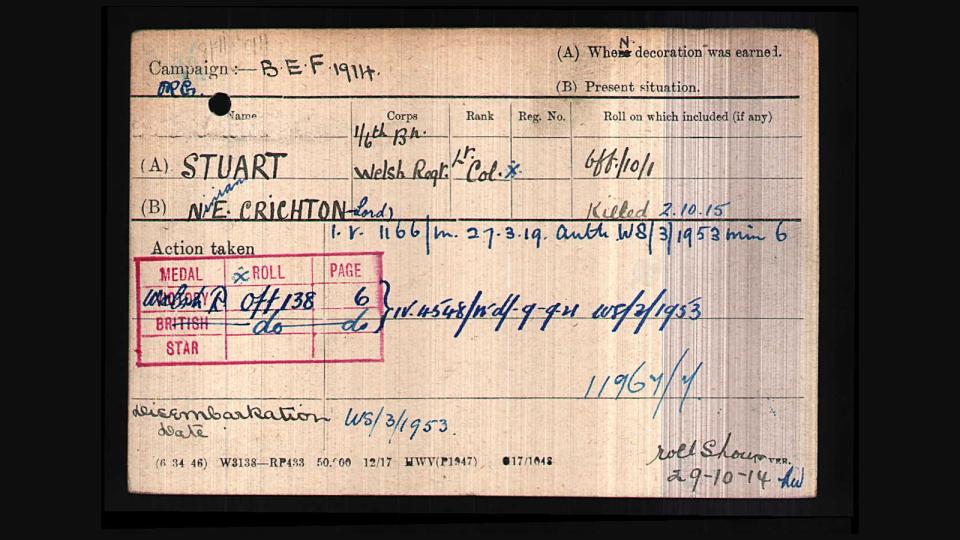
Lord Ninian's Medal Index Card, returned to his family upon his death.
The first news of Lord Ninian’s death was received in London by the dowager Lady Bute, his mother. He was survived by his wife Ismay and three of their children (Ismay, Claudia and Michael), his eldest also named Ninian, having died an infant in 1910.
As a point of administration here, Lord Ninian became the fifth MP to die during the great war, after The Hon. T.C.R Agar-Robarties (Mid-Cornwall); The Hon. A.E.B. O’Neill (Mid-Antrim); Mr W.G.C Gladstone (Kilmarnock Burghs); and Mr. H.T Cawley (Heywood, Lancs). A total of 22 MPs were killed during the conflict, though Lord Ninian was the only Welsh member. He is buried in Béthune Town Cemetery in Northern France. I will visit his grave to pay my respects in the near future.
A man, ostensibly thought of in the highest esteem: from his Cardiff constituency and through the counties of Wales; to the Houses of Parliament and north to Falkland in Fife. Not only did Lord Ninian Crichton-Stuart secure a future for our Football Club, but he made an enormous impact on the people of Cardiff, Wales, and the United Kingdom itself.
To tell us your stories of war heroes past and present, email forever@cardiffcityfc.co.uk.
